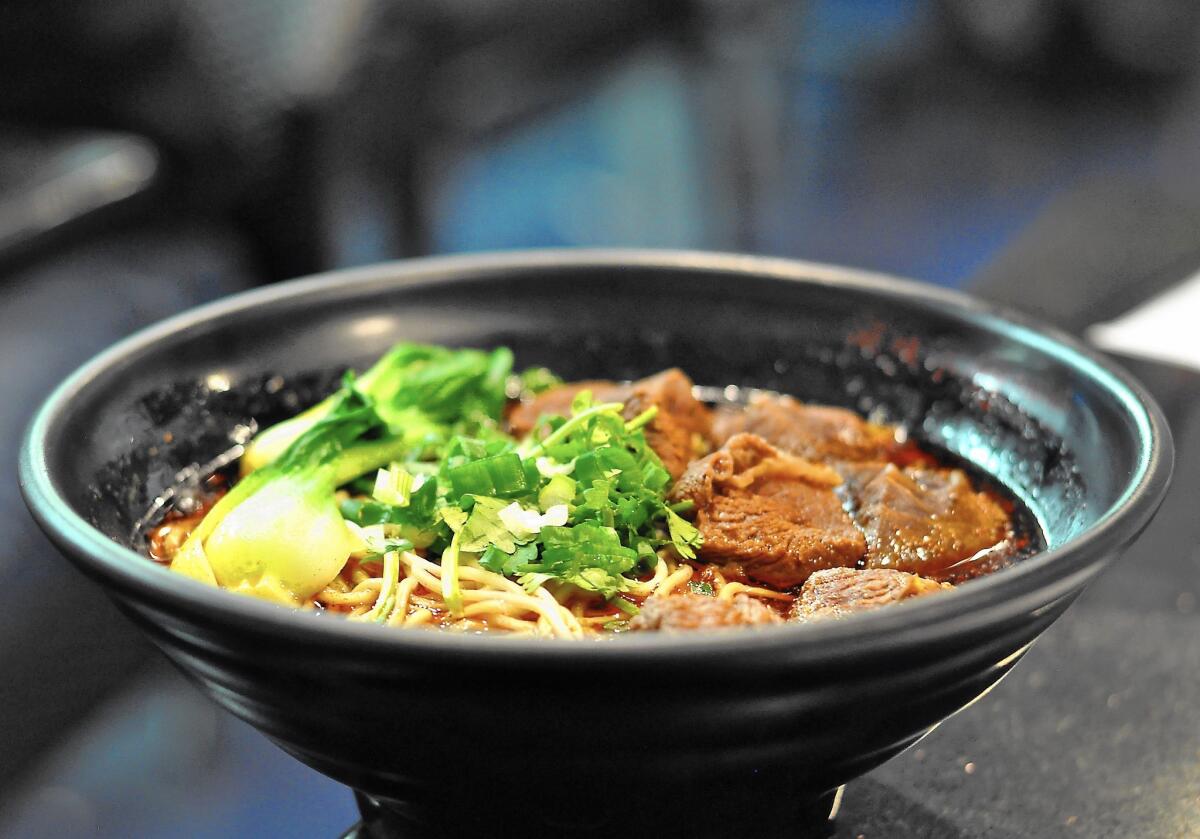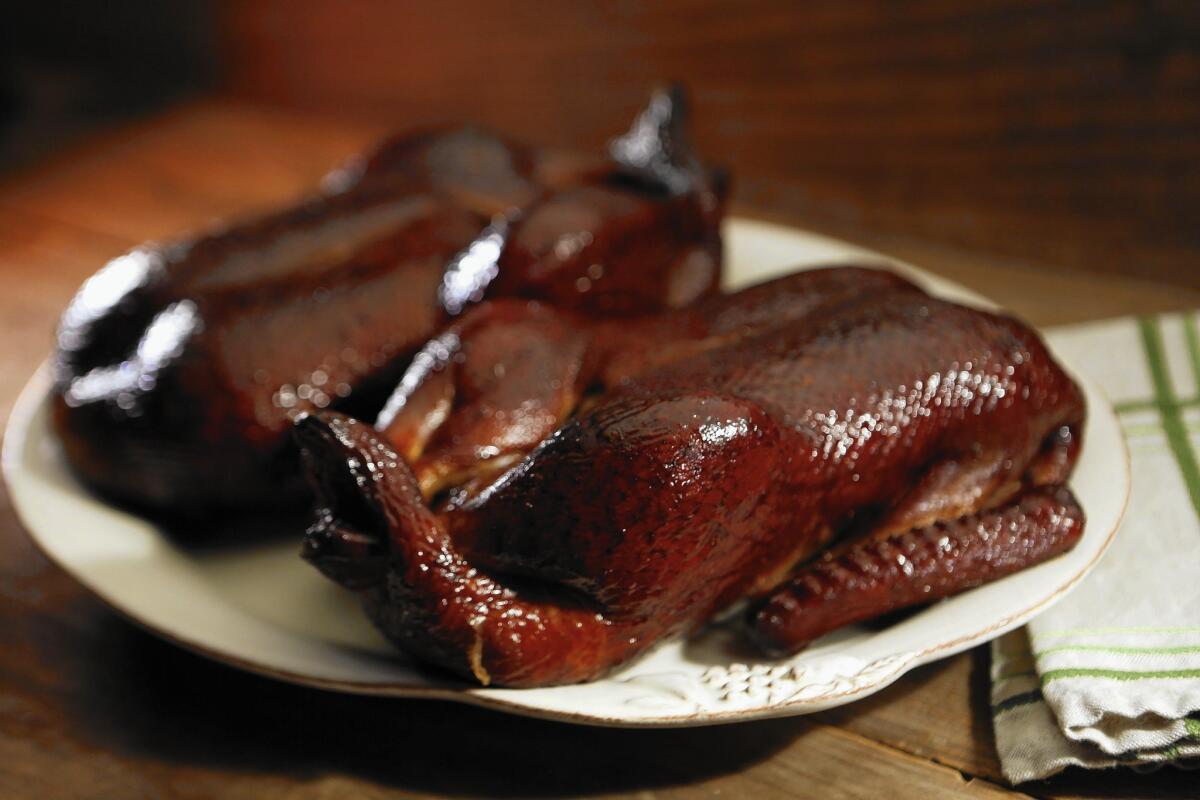What we’re into: Slurping zhajiangmian, hunting duck and reminiscing with Thrifty ice cream
Zhajiangmian
You know zhajiangmian. It’s that dish of springy wheat noodles tossed with bean sauce, ground pork and usually some other stuff that you find in some of the better Chinese noodle restaurants. In Korean noodle houses like Mandarin House and Lee Man Gu, where it is spelled something like jajangmyun, the sauce is as dark and thick as motor oil, although the noodles remain hand-pulled. And now there’s the truly excellent Chengdu zhajiangmian at Mian in San Gabriel, the brand-new Chongqing-style noodle house opened by Tony Xu, the chef behind the astonishingly popular Chengdu Taste restaurants in Alhambra, Rosemead and Rowland Heights.

The zhajiangmian looks like versions you may have had before, a bowl whose surface is frosted with ground pork and scallions, and the chewy pull is familiar. These are noodles with a mean streak, a potent lashing of hot chile and oil, laced with Sichuan peppercorn that numbs your palate just enough to make the next bite not just tolerable but actually kind of great. If for some reason Chengdu zhajiangmian doesn’t seem like your thing, the short menu also includes seafood noodles, spicy gizzard noodles, and noodles in bone broth with fried egg, as well as dumplings in chile oil. The side dishes of spicy dried radish and tingly-tart pickled cabbage are reasons enough to visit on their own.
— Jonathan Gold

Duck, duck, duck
It’s the last few days of duck season in California if you happen to hunt, as some of us do. Fans tend to think of duck as the steak of the poultry world, as it’s so much more robust in flavor than, well, chicken. I’ve taken my share of pintails, gadwalls and teals. (Though I try to avoid diver ducks, as they can taste a little fishy.) Although the cooking options are almost endless — do you want to sauté, braise, roast or even stew your duck? — now is the perfect time to give your grill a little love by smoking your birds. Bathe your duck overnight in a brine flavored with maple, rosemary, mustard and bourbon (the cook should always sample the liquor to make sure it’s satisfactory, more than once if necessary), then slow-smoke the bird over hickory. It’s magical. Even if you don’t hunt, store-bought ducks are just fine — in fact, they’re bigger than most of the ducks you’ll find out in the wild and, thankfully, they’re already plucked and cleaned.
— Noelle Carter

Thrifty ice cream
We’re in the middle of an artisanal ice cream boom. There’s no shortage of lavender-scented, salted-caramel, tomato-infused or tea-flavored ice cream in Los Angeles. But sometimes you just want an old-fashioned scoop of ice cream from Rite Aid. If you grew up in Southern California, you’re probably familiar with Thrifty drug stores, since taken over by Rite Aid but still selling ice cream under the Thrifty name. You may have lovingly cherished a scoop (and dripped a little on your OshKosh denim jumper) while your mom waited for a prescription and browsed the nail polish aisle. The Thrifty ice cream counter is where you’ll find bright green mint chip, cherry chip vanilla and bubble gum flavors. These ice creams are not organic. And the one flavor the most deserving of its cult following is the chocolate malted crunch. Rectangular chocolate chips are mixed into a rich chocolate ice cream dotted with tiny malted crunch balls. These distinctly squared-off scoops of ice cream should be eaten in a cone — preferably the cardboard-ish in texture, paper-wrapped sugar cones stored in the boxes that say “Super Treat.” They are a super treat indeed, made even better when eaten next to a display of discounted holiday wrapping paper and popcorn tins in the middle of an aisle. This is your childhood, in a cone.
— Jenn Harris

Lighten up with a Negroni Sbagliato
When someone orders a Negroni at a bar, you know they’re either a serious cocktail connoisseur — or have at least dated one. The classic Italian drink is a deliciously bittersweet mixture of equal parts Campari, sweet vermouth and gin. It’s also one of the easiest drink recipes to remember, and one of the best recipe to casually pull out of your hat at a party, like you’ve been slinging these things for years. If you stop into Ledlow, Josef Centeno’s downtown restaurant at the corner of 4th and Main streets, for a late-night drink, you can sip a Negroni Sbagliato for $5. This is the Negroni’s lesser popular but just as attractive second cousin. In Italian, “sbagliato” means “wrong.” According to imbibing legend, a fast-moving bartender accidentally poured sparkling wine into a customer’s Negroni instead of gin. The happy accident created a version of the classic that’s lighter and decidedly more refreshing. And if you happen to also be a fan of the Aperol spritz but crave something with more of a punch, this is it.
— Jenn Harris
‘No Man Is an Island’ a colorful look at Haitian chef TiGeorges Laguerre
Cookbook of the Week: “No Man Is an Island,” by TiGeorges Laguerre with Jeremy Rosenberg (Rare Bird Books, $15.95). This isn’t so much a cookbook as it is a memoir of a life spent cooking, from a chef whose life probably deserves not one, but a dozen memoirs. Jean-Marie Montfort Hébert Georges Fils Laguerre goes by the name TiGeorges, as does his restaurant, TiGeorges’ Chicken, one of the only Haitian joints in Los Angeles. It was that restaurant near Echo Park that became the L.A. center of disaster relief after the earthquake that devastated Haiti in 2010. And that restaurant nearly burned to the ground after an electrical fire only months after the earthquake. Laguerre’s book weaves between these catastrophic events, but it also covers his childhood in Port-de-Paix, Haiti, his early days cooking in Los Angeles, and the genesis of the restaurant, which has reopened after fire repairs. TiGeorges the restaurant is a cultural center as much as a place to eat, where the Haitian community gathers, where musicians play and where Laguerre continues to make astonishing roast chicken on the grill he built at the front of the place, a contraption that looks more like a medieval catapult than a normal rotisserie. TiGeorges the author has created a kind of cultural center with this book, dishing out his food and his life in equal, colorful measure.
MORE:
What We’re Into: Congee, fresh-baked bread and tofu tacos
What’s looking good in the food world right now
More to Read
Eat your way across L.A.
Get our weekly Tasting Notes newsletter for reviews, news and more.
You may occasionally receive promotional content from the Los Angeles Times.









